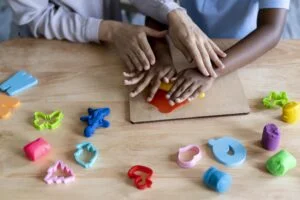A list of 50 best activities for children with autism allows for a diverse range of options to cater to individual preferences and needs. Here is a comprehensive list of activities, which includes sensory, communication, social, physical, indoor, and outdoor activities:
Sensory Activities:

- Sensory bins with different textures and objects.
- Fidget toys for tactile and visual stimulation.
- Water play in a sensory table or bathtub.
- Creating sensory-friendly art using various materials.
- Sensory rooms with calming lights, textures, and sounds.
Communication and Social Activities:

- 6. Social stories to explain social situations.
- Visual schedules for routine predictability.
- Playdates with understanding peers.
- Puppet shows to practice communication and storytelling.
- Role-playing social scenarios.
Physical Activities:

11. Swimming for sensory and physical benefits.
- Yoga for balance, flexibility, and relaxation.
- Trampoline play to expend energy.
- Obstacle courses for gross motor skill development.
- Dance classes for rhythm and self-expression.
Indoor Activities:

16. Sensory-friendly movie nights.
- Building with LEGO or other construction toys.
- Indoor scavenger hunts.
- Board games that encourage social interaction.
- Cooking or baking together.
Outdoor Activities:

21. Nature walks in local parks or nature reserves.
- Gardening to foster responsibility and sensory engagement.
- Visiting petting zoos or farms for animal interactions.
- Bike riding with proper safety equipment.
- Picnics in local parks.
Sensory Art Activities: 
26. Painting with various textured brushes.
- Creating textured collages with fabric and paper.
- Pottery and clay sculpting.
- Sand art using different colors and textures.
- Outdoor sidewalk chalk art.
Science and Exploration: 
31. Simple science experiments at home.
- Stargazing and learning about constellations.
- Bird watching or identifying local wildlife.
- Exploring the beach and collecting seashells.
- Visiting science museums and interactive exhibits.
Music and Sound Activities: .

36. Music therapy sessions
- Playing musical instruments like drums or keyboards.
- Creating soundscapes with everyday objects.
- Sing-along sessions with favorite songs.
- Music and movement activities.
Educational Activities:

41. Reading books together.
- Educational apps and games on tablets.
- Building puzzles and spatial awareness games.
- Learning sign language or augmentative communication systems.
- Engaging in math or logic puzzles.
Art and Craft Activities:
46. Creating personalized photo albums or scrapbooks.
- DIY crafting with recycled materials.
- Jewelry making with beads and strings.
- Painting rocks and leaving them as gifts in the community.
- Making cards for family members and friends.
Remember, the key is to adapt activities to the child’s individual interests and needs. Some children may enjoy a mix of these activities, while others may have specific preferences. Creating a supportive and understanding environment is crucial to ensuring that these activities are both enjoyable and beneficial for children with autism.
Readers are invited to share their own experiences and suggestions in the comments, fostering a sense of community and shared learning.







I was suggested this web site by my cousin Im not sure whether this post is written by him as no one else know such detailed about my trouble You are incredible Thanks
[…] Click here for: Sensory Toys, Products & Tools […]
[…] to share your own insights, please do not hesitate to get in touch. Click for SENSORY Products & Tools PreviousNavigating the Diagnosis of Autism Spectrum Disorder (ASD): […]
[…] signs to look for, and the importance of early intervention and support. Click for the List of all 11 Books PreviousNavigating Social Security Benefits for Individuals with […]
[…] Occupational therapy plays a crucial role in supporting individuals with autism in developing essential life skills and strategies. Through an individualized, client-centered approach, occupational therapists empower individuals with autism to lead more independent and fulfilling lives. If you or someone you know is living with autism, exploring occupational therapy might be the key to unlocking a brighter, more inclusive future. Contact Us More Blogs Volunteer Click for SENSORY TOOLS & PRODUCTS […]
[…] Click here: For Sensory Products […]